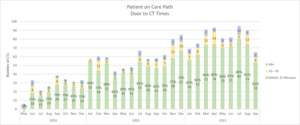
Getting a better view of stroke care performance
When a patient comes to the emergency department (ED) with stroke symptoms, receiving a diagnosis and treatment in a timely manner is everything. Waiting too long can lead to major brain damage or even death.
That’s why many hospitals across the nation have care paths in place to respond to this medical situation. OSF HealthCare built the ED Stroke Care Path into the electronic medical record (EMR) in 2019 to help guide clinicians on the appropriate course of treatment.
However, there wasn’t an easy way to measure how well the path was performing across the Ministry compared to years when the treatment plan wasn’t in place.
“The stroke program has been tracking data for years,” said Dr. Arun Talkad, director of Inpatient Vascular Neurology for OSF and department chairman for Neurology at OSF HealthCare Saint Francis Medical Center. “The problem was that our facilities were all tracking metrics in different ways. We needed to not only standardize data collection, but we also needed the ability to view it from one central location.”
 The OSF HealthCare Illinois Neurological Institute (INI) worked with Healthcare Analytics to build the Stroke Dashboard, a one-stop shop that provides an overview of care for ischemic and hemorrhagic stroke patients at EDs across the Ministry. This gives OSF INI a reliable source of data to easily evaluate processes and performance.
The OSF HealthCare Illinois Neurological Institute (INI) worked with Healthcare Analytics to build the Stroke Dashboard, a one-stop shop that provides an overview of care for ischemic and hemorrhagic stroke patients at EDs across the Ministry. This gives OSF INI a reliable source of data to easily evaluate processes and performance.
The Stroke Dashboard
The Stroke Dashboard tracks four metrics, including the use of CT scans, delivery of the drug called tPA, stroke documentation and application of the ED Stroke Care Path. It includes more than two years of data that comes from the EMR.
“The dashboard went live at about the same time the Stroke Care Path was launched within the EMR,” said Taylor Gladfelter, a senior clinical analyst for Healthcare Analytics. “That gave us the ability to gauge whether the addition of the care path is improving patient care.”
According to the dashboard, the use of the Stroke Care Path reduced the time it takes to get a patient into a CT scan by four minutes. It also resulted in a five-minute decrease in the time it takes to administer tPA, a time-sensitive, blood clot-busting drug to ischemic stroke patients.
“This information ties back to the basic need for this dashboard,” Dr. Talkad said. “If we didn’t know how we were doing from the beginning, then we don’t know that we’re actually getting any better or worse. Based on that initial data, we can now say people on the Stroke Care Path are not just getting tPA, they’re getting it faster.”
Outcomes from the Stroke Dashboard have led to the development of an inpatient version of the Stroke Care Path. After a stroke patient is admitted to the hospital, the EMR will ensure care protocols are followed at the appropriate times, such as the delivery of blood thinners and cholesterol medications and other therapies that prevent complications from a stroke. This information will also feed into the Stroke Dashboard.
“Right now, the dashboard only provides an emergency department view of stroke care with those metrics beginning with the first signs of a stroke through the ED,” Gladfelter said. “As the new pathway starts getting utilized more, the future of the stroke dashboard will look more all-encompassing of the entire hospital care journey for stroke patients.”
‘An extension of the clinical team’
OSF INI stroke team sought to work with Healthcare Analytics as it believes data use is fundamental to the transformation of health care.
“We really see the Healthcare Analytics team as an extension of the clinical team,” said Dr. Talkad. “They may not be MDs or RNs, and they’re not at the bedside, but they’re able to measure us from a very objective, data-driven point of view. That gives us the information we need when determining whether to improve or innovate our practices.”

